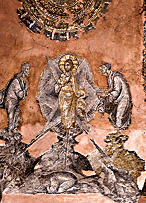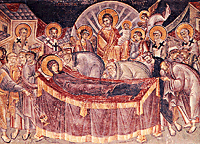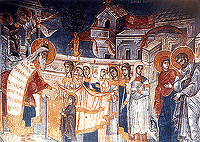 |
|
 |
Thessalonike - Mount Athos
 t the beginning of the century Thessalonike
t the beginning of the century Thessalonike
 was to enjoy a remarkable economic and cultural florescence. In the city, already a major artistic centre with a long tradition since very early times, a large number of 14th-century monuments survive. These monuments share common features both in their architecture and in the wall paintings that adorn them, and they influenced the art of the wider areas within the cultural radius of the city. was to enjoy a remarkable economic and cultural florescence. In the city, already a major artistic centre with a long tradition since very early times, a large number of 14th-century monuments survive. These monuments share common features both in their architecture and in the wall paintings that adorn them, and they influenced the art of the wider areas within the cultural radius of the city.
Among the monuments that still survive in Thessalonike and bear witness to the intense artistic activity and therefore to the economic prosperity of the city at that time, are the churches of the Holy Apostles, of St. Catherine, of St. Nicholas Orphanos, the Blatadon monastery, the small church of the Saviour and the church of St.
 Panteleemon. To the same period belong also the present-day church of the prophet Elijah, which was identified with the katholikon of the Nea Mone built by a powerful personage of the time, Makarios Choumnos, on the site of a palace destroyed during the Zealot uprising. Nevertheless, modern scholars have proposed that the church of the Prophet Elijah was identical with the monastery of Akapniou, a very famous monastic institution linked with the ruling dynasty of the Palaiologoi. Panteleemon. To the same period belong also the present-day church of the prophet Elijah, which was identified with the katholikon of the Nea Mone built by a powerful personage of the time, Makarios Choumnos, on the site of a palace destroyed during the Zealot uprising. Nevertheless, modern scholars have proposed that the church of the Prophet Elijah was identical with the monastery of Akapniou, a very famous monastic institution linked with the ruling dynasty of the Palaiologoi.
The artists of the city were probably much sought after and were widely renowned. We know of at least three who worked in neighbouring cities and who were also employed by the Serbian
kralj Milutin.
Kallierges, who decorated the church of Christ in Berroia, was one of these celebrated artists.
 On Mount Athos not all the churches have been systematically studied from an architectural point of view, and that because the number of buildings, besides the katholikon, constituting the 20 monasteries is very great. However, we know that it is during this period that the
katholikon
of the Hilandar monastery was built by craftsmen from Constantinople, and that the katholikon of the Vatopedi monastery was adorned with particularly fine frescoes (1312). On Mount Athos not all the churches have been systematically studied from an architectural point of view, and that because the number of buildings, besides the katholikon, constituting the 20 monasteries is very great. However, we know that it is during this period that the
katholikon
of the Hilandar monastery was built by craftsmen from Constantinople, and that the katholikon of the Vatopedi monastery was adorned with particularly fine frescoes (1312).
See also: 2nd Civil War-Zealots
|

